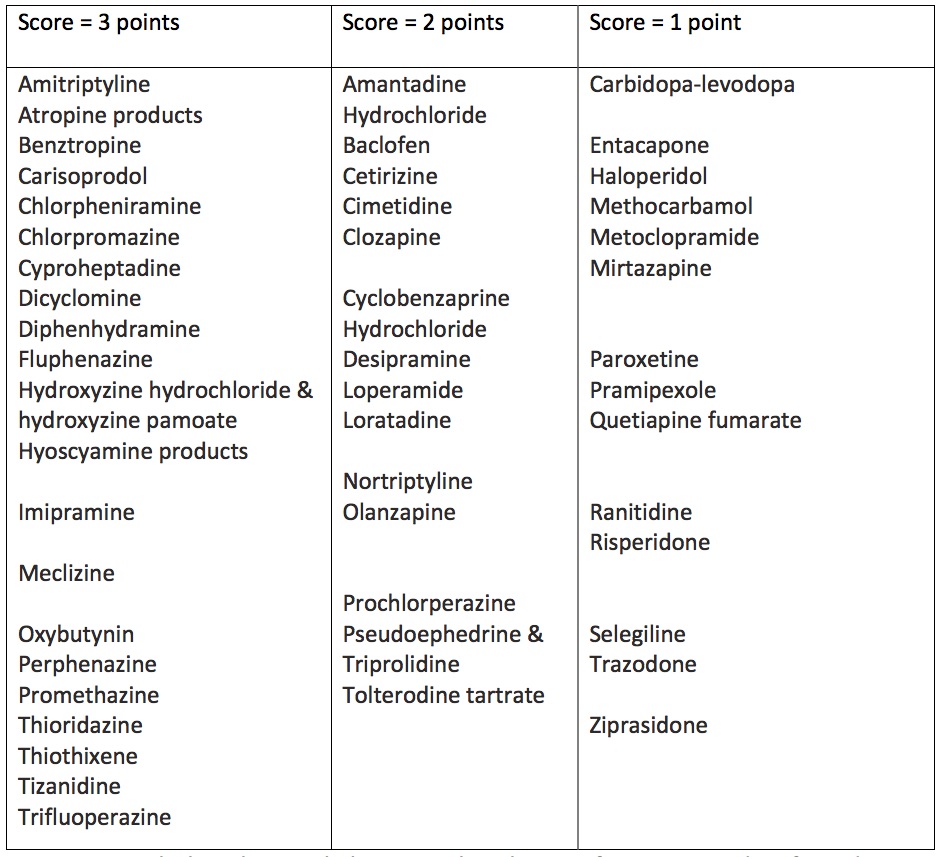| Anticholinergic Burden Assessment and Future Diagnosis of Dementia |
|
by Janice Hoffman Simen, PharmD, EdD, APP, BCGP, FASCP Recently, an article published in the British Medical Journal, April 2018, looked at patients in the UK with a new dementia diagnosis and the use of prescription medications with anticholinergic adverse effects up to 20 years previously (Richardson, et al., 2018). In this study, the researchers found a link between a new dementia diagnosis and an increasing average Anticholinergic Burden score (ACB). According to the results of this study, the risk of dementia increases with an ACB greater than three, including exposure 15-20 years prior to diagnosis, with the following drug classes: antidepressants, urologic, and antiparkinson agents. The findings are interesting as a risk factor for the onset of dementia and encourages the assessment of anticholinergic burden in younger patients. Once the dementia diagnosis is made, and Acetylcholinesterase inhibitors (AChE-I) are to be given, the Anticholinergic burden becomes more taxing. Anticholinergic effects oppose the action of AchE-I which increase the amount of acetylcholine available in the brain. According to Lexicomp, anticholinergic agents may diminish the therapeutic effects of AChE-Is and vice versa, since they have opposing mechanisms leading to potential inactivation of each other. Eighteen anticholinergic burden scales or tools are available to quantify the anticholinergic activity of medications (Welsh, et al., 2018). The simplest and most efficient scale is the Anticholinergic Risk Scale (Rudolf, et al., 2008) with an updated list of medications presented as a poster at AGS in 2013 (Campbell, et al., 2013) *Anticholinergic Risk Scale 2008  Scoring: To calculate the Anticholinergic Risk Scale score for a patient, identify medications the patient is taking and add the total points for each medication. *Adapted from Rudolph, J., Salow, M.J., Angelini, M. C., & McGlinchey, R. E. The Anticholinergic Risk Scale and Anticholinergic Adverse effects in Older Persons. Arch Intern Med. 2008;168(5):p. 512. Assessing anticholinergic burden, particularly in younger patients may help to reduce the burden in hopes of preventing the onset of dementia in later life. Reference Campbell NL, Maidment I, Fox C, et al. The 2012 Update to the Anticholinergic Cognitive Burden Scale. J Am Geriatr Soc 2013;61: S142-3. doi:10.1111/jgs.12263. Kouladjian L, Gnjidic D, Chen T, et al. DBI Calculator_. The Drug Burden Index Calculator 2016 [cited 2016 08 Nov 2016];1: [The Drug Burden Index Calculator]. Available from: https://drugburdenindex.com/Account/Login?ReturnUrl=%2f. Lexicomp 2018. Donepezil and Amitriptyline Drug Interaction Level C. Retrieved on 5/14/18 http://online.lexi.com.proxy.westernu.edu/lco/action/interact Richardson K, Fox C, Maidment I, Steel N, Loke YK, Arthur A, Myint PK, Grossi CM, Mattishent K, Bennett K, Campbell NL, Boustani M, Robinson L, Brayne C, Matthews FE, Savva GM. Anticholinergic Drugs and risk of dementia: case-control study. BMJ. 2018 Apr 25;361:k1315. doi: 10.1136/bmj.k1315.https://www.bmj.com/content/bmj/361/bmj.k1315.full.pdf Rudolph, J., Salow, M.J., Angelini, M. C., & McGlinchey, R. E. The Anticholinergic Risk Scale and Anticholinergic Adverse effects in Older Persons. Arch Intern Med. 2008;168(5):508-513 Salahudeen MS, Duffull SB, Nishtala PS. Anticholinergic burden quantified by anticholinergic risk scales and adverse outcomes in older people: a systematic review. BMC Geriatr. 2015;15:31. Welsh TJ, vander Wardt, V, Olio, G., Gordon, A.L., & Gladman, J.R.F. Anticholinergic Drug Burden Tools/Scales and Adverse Outcomes in Different Clinical Settings: A Systemic Review of Reviews. Drugs Aging. 2018 May 8doi: 10.1007/s40266-018-0549-z. [Epub ahead of print] |

